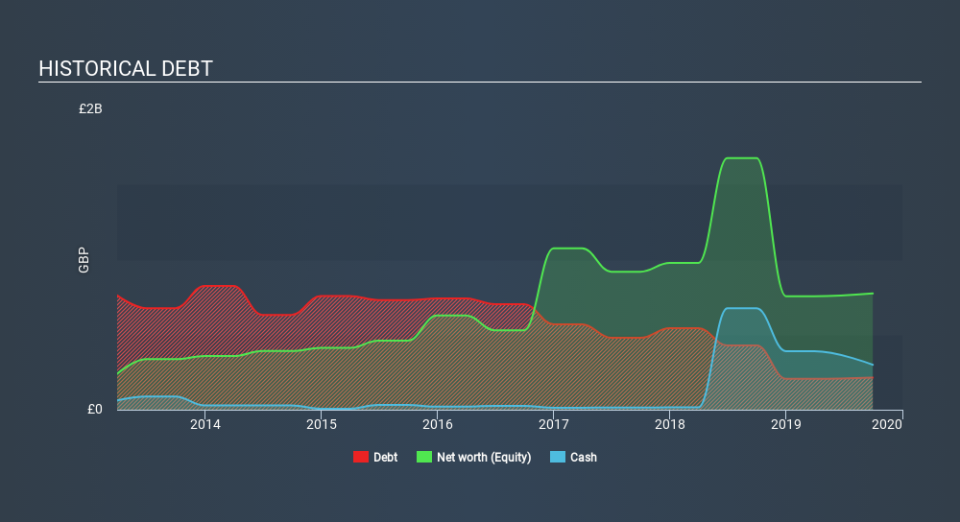Is Daily Mail and General Trust (LON:DMGT) Using Too Much Debt?

David Iben put it well when he said, 'Volatility is not a risk we care about. What we care about is avoiding the permanent loss of capital. It's only natural to consider a company's balance sheet when you examine how risky it is, since debt is often involved when a business collapses. We can see that Daily Mail and General Trust plc (LON:DMGT) does use debt in its business. But the real question is whether this debt is making the company risky.
What Risk Does Debt Bring?
Debt and other liabilities become risky for a business when it cannot easily fulfill those obligations, either with free cash flow or by raising capital at an attractive price. Ultimately, if the company can't fulfill its legal obligations to repay debt, shareholders could walk away with nothing. However, a more frequent (but still costly) occurrence is where a company must issue shares at bargain-basement prices, permanently diluting shareholders, just to shore up its balance sheet. Having said that, the most common situation is where a company manages its debt reasonably well - and to its own advantage. The first step when considering a company's debt levels is to consider its cash and debt together.
View our latest analysis for Daily Mail and General Trust
What Is Daily Mail and General Trust's Net Debt?
You can click the graphic below for the historical numbers, but it shows that Daily Mail and General Trust had UK£214.6m of debt in September 2019, down from UK£428.0m, one year before. However, it does have UK£299.1m in cash offsetting this, leading to net cash of UK£84.5m.
How Healthy Is Daily Mail and General Trust's Balance Sheet?
Zooming in on the latest balance sheet data, we can see that Daily Mail and General Trust had liabilities of UK£629.3m due within 12 months and liabilities of UK£231.8m due beyond that. Offsetting this, it had UK£299.1m in cash and UK£289.5m in receivables that were due within 12 months. So its liabilities total UK£272.5m more than the combination of its cash and short-term receivables.
Since publicly traded Daily Mail and General Trust shares are worth a total of UK£1.80b, it seems unlikely that this level of liabilities would be a major threat. Having said that, it's clear that we should continue to monitor its balance sheet, lest it change for the worse. While it does have liabilities worth noting, Daily Mail and General Trust also has more cash than debt, so we're pretty confident it can manage its debt safely.
While Daily Mail and General Trust doesn't seem to have gained much on the EBIT line, at least earnings remain stable for now. There's no doubt that we learn most about debt from the balance sheet. But it is future earnings, more than anything, that will determine Daily Mail and General Trust's ability to maintain a healthy balance sheet going forward. So if you want to see what the professionals think, you might find this free report on analyst profit forecasts to be interesting.
But our final consideration is also important, because a company cannot pay debt with paper profits; it needs cold hard cash. While Daily Mail and General Trust has net cash on its balance sheet, it's still worth taking a look at its ability to convert earnings before interest and tax (EBIT) to free cash flow, to help us understand how quickly it is building (or eroding) that cash balance. Over the last three years, Daily Mail and General Trust recorded free cash flow worth a fulsome 89% of its EBIT, which is stronger than we'd usually expect. That puts it in a very strong position to pay down debt.
Summing up
Although Daily Mail and General Trust's balance sheet isn't particularly strong, due to the total liabilities, it is clearly positive to see that it has net cash of UK£84.5m. The cherry on top was that in converted 89% of that EBIT to free cash flow, bringing in UK£125m. So we don't think Daily Mail and General Trust's use of debt is risky. When analysing debt levels, the balance sheet is the obvious place to start. But ultimately, every company can contain risks that exist outside of the balance sheet. Take risks, for example - Daily Mail and General Trust has 3 warning signs (and 1 which makes us a bit uncomfortable) we think you should know about.
If you're interested in investing in businesses that can grow profits without the burden of debt, then check out this free list of growing businesses that have net cash on the balance sheet.
If you spot an error that warrants correction, please contact the editor at editorial-team@simplywallst.com. This article by Simply Wall St is general in nature. It does not constitute a recommendation to buy or sell any stock, and does not take account of your objectives, or your financial situation. Simply Wall St has no position in the stocks mentioned.
We aim to bring you long-term focused research analysis driven by fundamental data. Note that our analysis may not factor in the latest price-sensitive company announcements or qualitative material. Thank you for reading.


